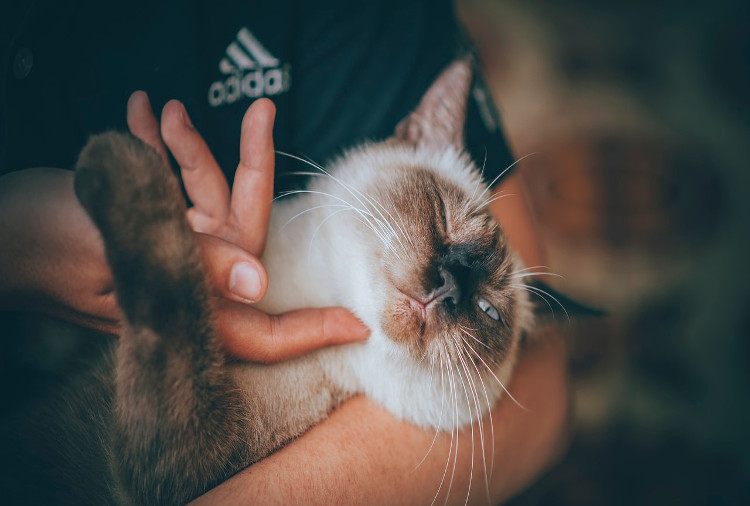![]()
Would you believe that cats, like humans, can get acne too? This condition consists of blackheads (medical term: comedones) that form on the face, typically at the chin or around the lips of cats.
What is Cat Acne?
Like with human acne, cat acne tends to be a mild condition that may not cause any problems or discomfort to your cat. While in humans the cosmetic aspect of blackheads can be a major concern, cats are not affected by this concern, especially due to the affected areas typically being covered by hair.
Feline acne is the appearance of comedones or blackheads on or around the chin and lips. When the condition is mild, it is tough to appreciate the presence of blackheads on a kitty due to the hair on their chin and facial skin. When infected by bacteria, the blackheads may turn into pustules (pimples) which results in visible abnormalities such as unhappy skin (dermatitis) at the chin and face, presence of crusting at skin, and discomfort leading to itchiness. In some cases, feline acne can become persistent or severe recurring skin lesions that lead to ongoing discomfort to cats.
Though it is a typically uncomplicated skin condition of cats, veterinary evaluation is warranted if your cat’s facial skin doesn’t appear healthy, or skin lesions are noted at chin, lips, or anywhere else on the body.
Symptoms of Cat Acne
While it is generally a mild condition, acne can still cause discomfort for your cat. If you notice any of the following, consult your vet or veterinary dermatologist as soon as possible:
- Crusty lesions under the chin or on the lips
- Hair loss at chin or lips
- Signs of pain or discomfort
- Irregular or thickened skin at chin
- Excessive itching or scratching at face
- Thinning or matted hair
Remember, multiple types of skin disorders other than facial acne in cats can cause crusting of skin, dermatitis (inflamed skin), hair loss, and signs of itchiness around the face for cats.
Other possible causes for similar symptoms may include an allergy to food or environment, fungal infection (ringworm or dermatophytosis), and pemphigus foliaceus (an autoimmune disease).
Causes of Feline Acne
Inflammation of the hair follicle and associated glands as well as changes in keratin production associated with the hair follicle lead to feline acne. Sebaceous glands around hairs produce oil, called sebum, which supports the skin and hair.
Due to changes associated with the hair follicle, the opening of this follicle (pores of the skin) may become plugged with materials produced by the skin and follicular glands. Opening of the hair follicle may even get dilated. This leads to formation the black heads and, possibly, secondary infection due to bacteria may set in. If present, bacterial infection is usually a secondary problem and not the original cause.
Feline acne is regarded to be a cosmetic disease in cats that can be symptomatically managed well and usually does not affect their long term quality of life.
Diagnosis of Cat Acne
Making a diagnosis of chin acne for cats is usually based on the presentation of symptoms and detailed dermatology examination. The extent and duration of the symptoms are helpful indicators, as is the presence or absence of additional skin or ear related symptoms your cat may have.
Often, screening for bacterial or fungal infection may be needed so that successful treatment can be recommended. Skin biopsy will usually confirm the diagnosis, especially for complicated cases, but most patients with feline acne can be diagnosed with thorough dermatology evaluation and skin biopsy may not always be needed.
Treatment and Management
Feline acne is not a curable condition and usually persists for life, but the good news is that it is usually fairly easy to control once diagnosed. The aim of treatment is to reduce discomfort, skin lesions, and development of local infections due to skin inflammation. If chin acne is present due to an underlying condition such as skin related allergies, good control can also be achieved with adequate management of the allergy (which may be related to environmental or food related allergy).
Cats may need ongoing management of acne related symptoms in order to prevent complications, and this is generally easily performed after the diagnosis has been made.
Those zits a.k.a blackheads may be concerning when first noted, but once diagnosed and controlled, they aren’t as scary long term and your cat won’t stress about facial acne as a person might!
Creative Commons Attribution: Permission is granted to repost this article in its entirety with credit to VetDERM Clinic and a clickable link back to this page.

Dr. Jangi Bajwa is a Board certified veterinary dermatologist at VetDERM Clinic in Surrey BC. He is also the dermatology feature editor for Canadian Veterinary Journal. Dr. Bajwa’s special interests include otitis and allergic disease in pets; as well as helping improve quality of life of pets and their families.



 by
by